What to Do With Beef Bone Fat
I may receive a commission if you purchase through links in this post. I am not a doctor; please consult your practitioner before changing your supplement or healthcare regimen.
In this How to Make Bone Broth and Avoid Rancid Fat post, I present a complete guide to cooking techniques (and health-safety issues) that other bone broth recipes don't teach. With gut-nourishing amino acids, gelatin, and collagen, it's important to keep bone broth healthy by avoiding rancid fat production. This recipe teaches you how to make the best, pure bone broth in your Instant Pot, slow-cooker or on the stove top — with lots of variations and tips!
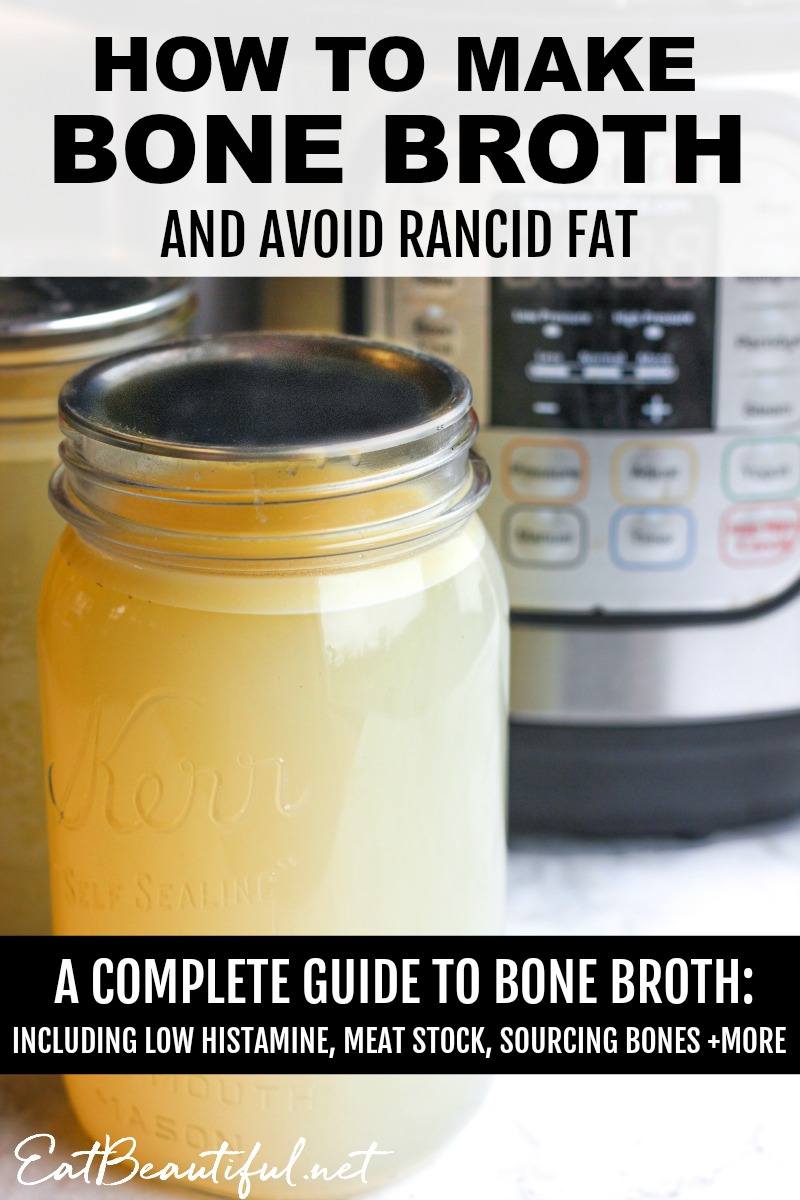
Being an altogether comprehensive article on how to make bone broth, this recipe addresses many subtopics, including: meat stock, low histamine broth, vegetables in broth-making, how to make broth mineral-rich, the best bones for broth, where to get bones for broth, fish stock and more.
For healing the gut, restoring good general health, reducing inflammation, fighting viruses, and a host of other benefits, bone broth (and meat stock — we'll talk more about this) are the most healthful, gentle tonics of all.
My background making bone broth
Our family owned a gut-healing cafe for about seven years where we made thousands of gallons of bone broth. Before that, we did the GAPS Introduction diet twice and the full GAPS Diet for over 6 years — the diet that first revealed bone broth to be unparalleled in its health benefits.
Doctors, especially cancer specialists, sent their patients to our cafe for bone broth and bone broth soups. We learned a lot in those years, and still implement the principles weekly in our home, where we continue a nourishing, gentle, intentional diet that includes meat stocks and bone broth.
May these guidelines and tips be helpful to you.
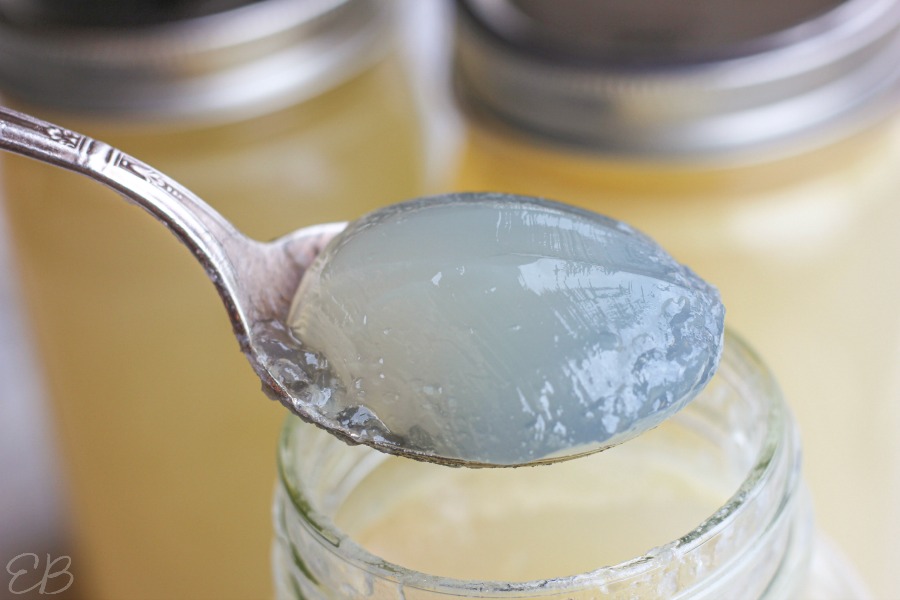
Surprising facts about bone broth:
- Bone broth is not high in minerals. Although most websites will tell you it is, and I thought so myself, too, at one time, it isn't. See these studies: 1, 2, 3, 4. In short, when broths cook for an extended period of time, it is protein that increases in broth, not minerals.
- Store bought broth is not as healthy. Convenient, yes, but you're not going to get the same flavor, sourcing (great, pasture-raised bones), quality control or nutrition from store bought cartons of broth. And homemade broth is not hard to make! In fact, I'm going to show you a super fast, easy recipe. It's a "dump and cook" no-brainer-easy recipe! 🙂
- Bone broth has a rival: Meat Stock! I actually prefer meat stock to bone broth for mid-week cooking! Meat stock is what's created in the first 2 to 3 hour simmer of the bones. It's super high in gelatin, gentle for invalids, and … the flavor is better! Plus, meat stock is faster and easier to make. But — is meat stock just as nourishing, just as gut-healing? Bone broth is higher in collagen than meat stock, but both are very high in gelatin. Gelatin should not be underestimated (read more about gelatin's benefits here). Its healing benefits are incredible. So yes, make bone broth too. But enjoy meat stock regularly, especially if it enables you to have it more often.
PRO TIP: You can combine your batches of meat stock and bone broth! When your meat stock AND bone broth batches are complete, pour them half and half into storage jars. You'll have a collagen-rich meat stock/bone broth combo that has the best flavor and nutrition.
PRO TIP 2: To increase the mineral content of broth, try adding dried nettles! (Find organic nettles here.) For this purpose, let the nettles steep in your hot broth for 5 to 20 minutes, then strain them to serve.
Rancid bone broth is common
In our first years on the GAPS diet, we simply boiled our bones for hours and hours. We didn't know that we were simmering fat, and creating a rancid product that 1) didn't always taste good and 2) wasn't healthy.
Actually, most recipes tell us to simply boil our bones for a long time — 24 to 48 hours, or 90 to 120 minutes in the Instant Pot. The recipe authors don't know: the fat MUST be strained off the top after 2 to 3 hours, or the broth is no longer health food.
Why rancid fat is unhealthy
This recipe isn't the place to go into all of the reasons rancid fat is unhealthy or how rancid fat is created, but I do want to share the basics briefly:
- Rancid fat destroys vitamins, which can lead to deficiencies (source).
- Ironically, the intestinal tract and flora health are two main areas that suffer when exposed to rancid fat (source).
- Rancid fat can cause toxic symptoms in humans, including a variety of symptoms that appear autoimmune in nature (source), again ironic for anyone trying to heal from autoimmune conditions … that we can make ourselves sicker with rancid bone broth.
Short story: We need to prevent fats from oxidizing to protect our health. Since heat and long-cooking can start the oxidative process, we need to be mindful about and practice conscientious cooking steps when making bone broth.
How to make Bone Broth and Meat Stock that avoid rancid fat
For the best, most nourishing bone broth, it's important to harvest the bones' broth at least two times:
- once after 2 to 3 hours for a very healing, high-fat broth called, Meat Stock
- once after 24 hours (this is your first harvest of bone broth) — or 90 to 120 minutes in the Instant Pot
- and again, optionally, after 48 to 72 hours (for a second harvest of bone broth from the same bones!) — or 90 more minutes in the Instant Pot
With this intention, each time you gather the broth from the bones, you simply add more water and sea salt, and keep going!
Two options
The first harvest of Meat Stock can simply be: Skim off all the fat, and keep the stock cooking. OR, harvest all the stock, add new water and salt for a fresh bone broth. This method is very economical, because for every set of bones, you get one batch of meat stock and one to two bone broths.
How to make bone broth and avoid rancid fat … You'll need:
Ingredients:
3 lbs bones — chicken feet or bones and cartilage (preferably from a pastured chicken), beef bones (grass-fed), or other sustainably-sourced animal bones, joints preferred, or exposed marrow
Optional: 2 Tablespoons raw apple cider vinegar (not ideal for those with FODMAP or fructose sensitivities); you can also use whey
Filtered Water: about 1-1/2 gallons
1 Tablespoon + 2 teaspoons sea salt (adjust according to pot size and to taste)
Method:
1. Add bones to stock pot, slow cooker or Instant Pot.
2. Fill with filtered water.
3. Add optional apple cider vinegar and sea salt.
4. Once the water begins to simmer, cook for 2 to 3 hours. Harvest all the fat, or fatty broth, using a ladle (keep the fat for another use, delicious in cooking!). This 2 to 3 hour broth is actually Meat Stock . (In the actual recipe below, I discuss how to harvest all the broth or just the fat, your choice.)
5. If you harvest all of the broth, you'll add new water, salt, and apple cider vinegar, and simmer on low at least 24 hours and up to 72 hours — or 90 minutes in the Instant Pot. (If using a pot on the stove, or a slow-cooker: within 30 minutes of the broth's first boiling, scum will rise to the surface; skim this off.)
6. Strain and use.
See (printable) Recipe Card below.
NOTES
- The fat from the first 2 to 3 hour boil NEEDS to be consumed (or skimmed off and saved) after this time period has elapsed. If the fat continues to boil, it will become rancid.
- My favorite broths are made from 1) chicken feet or 2) beef marrow bones.
What bones make the best bone broth and meat stock
Indeed, some bones make more delicious broths than other bones.
Chicken feet yield a very gelatin-rich and flavorful broth — buttery and unbelievably sustaining in nature. The many joints in the feet are a key source of gelatin and collagen. The whole leftover carcass of a chicken also makes delicious, good broth or stock.
Beef marrow bones yield a rich 1 to 2 tablespoons of marrow for every bone used. The marrow makes a good breakfast with broth and poached eggs. Accordingly, the first harvest beef marrow meat stock is rich and delicious! Served with the marrow itself and soft poached eggs, it is one of life's most hidden, culinary pleasures!
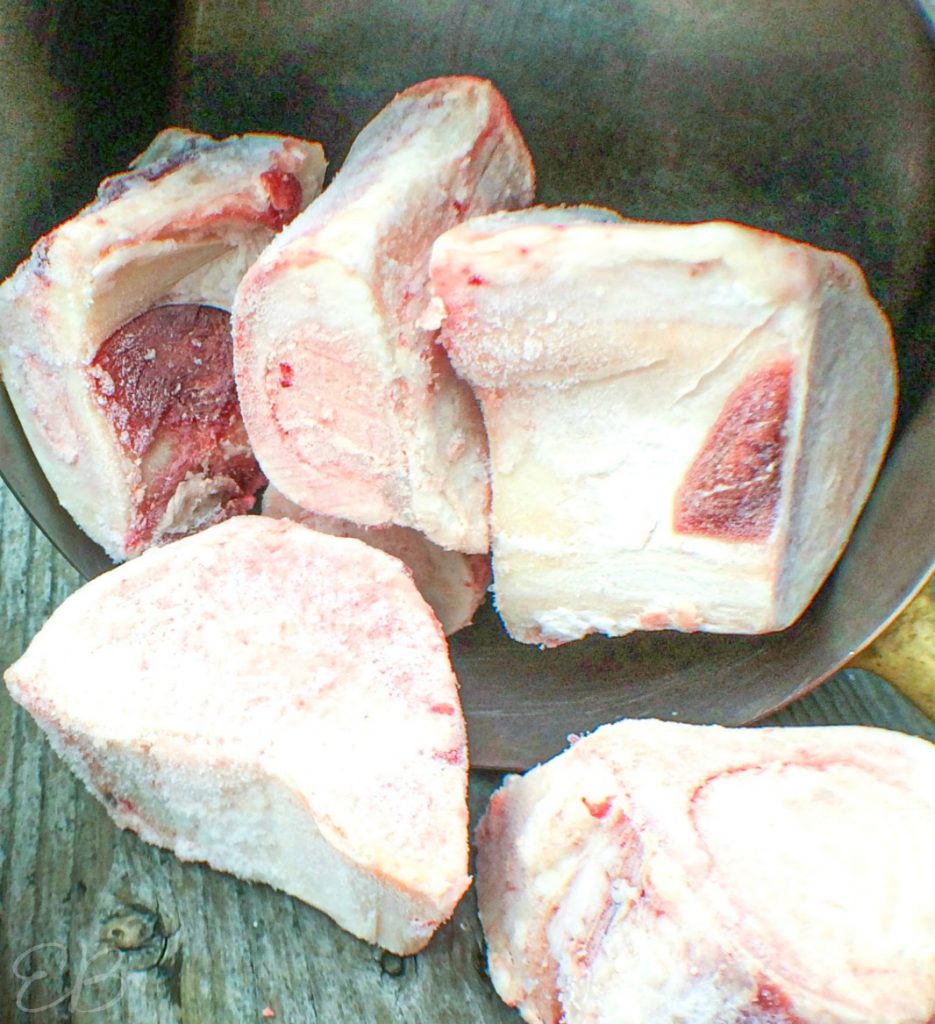
Where to buy bones for bone broth and meat stock
- Find a local pasture-raised chicken farmer. Many cities now have chicken farmers who care about sustainable farming.
- Ask a friend who raises chickens for eggs! When the chickens are done laying, they might be happy to part with their birds so you can make great broths and stocks.
- Look for a pasture-raised beef farmer. Marrow bones come from the femur bone, which is a big leg bone, inexpensive and plentiful for beef farmers. Joint bones are also a great thing to buy, and the farmer is happy to sell the whole animal!
- If you hunt or know someone who does, wild game bones make great bone broth and meat stock.
How much to pay for bone broth bones
Look for a price no higher than $3.99 a pound, but preferably cheaper!
If you get bones from a hunter or friend, you can get bones for free.
If you like fish stock, you can often get your fish monger to part with their bones for free!
How to make fish stock and shrimp stock (and avoid rancid fat)
So glad you asked! 🙂 Fish stocks are fabulous! My favorite is actually a seafood stock made from shrimp shells. But you can make a fish stock out of any fish bones! If you have a great fish monger/market in your town, and there's not much demand (which there rarely is), you can likely get fish bones with fresh, raw meat still on them, for free.
The main thing to know about fish stocks is that they are always made like a meat stock, not a bone broth — so a short cook time, to avoid rancid fat.
Thirty minutes of stove top simmering is all, and fish stocks are best enjoyed the day they're made. Shrimp stock is also good the next day.
Find How to Make Bonito Bone Broth here.
Ratio of ingredients
Regarding salt, start with half the amount you would use for a meat stock, and add more to taste, if needed, when the stock is done cooking.
That means: 2 to 3 pounds fish bones, 1 Tablespoon sea salt and 10 cups water for a large batch.
You can make a smaller batch if using shrimp shells (if you don't have that much weight). Add a bit of fresh garlic and/or fresh ginger to the finished stock.
Further, you can steep fresh herbs in the finished hot stock — like fresh tarragon, mint or rosemary.
Find the best recommendations on which shrimp to buy here.
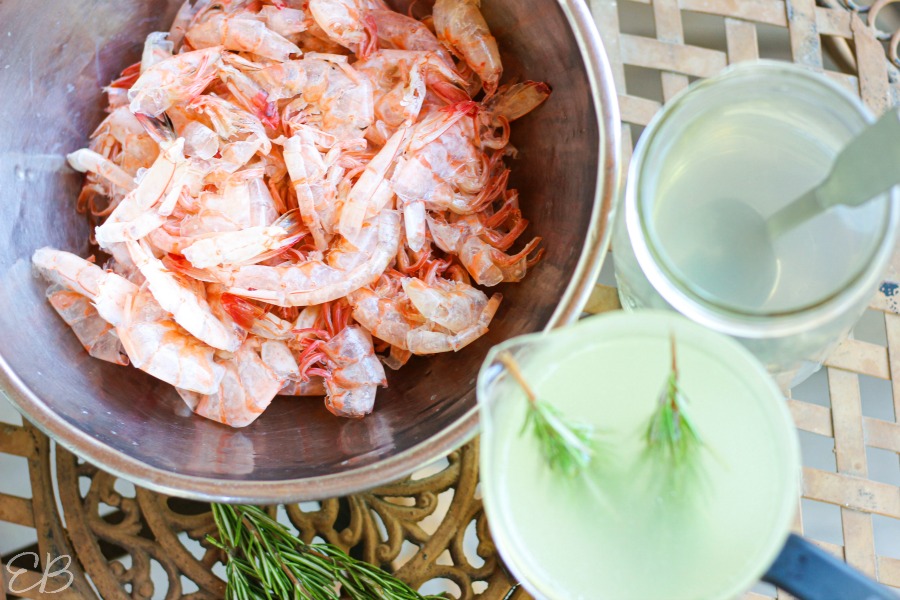
Fatty broth: Is it healthy?
Remember what Dr. Natasha Campbell-McBride, creator of the GAPS diet, says about the marrow, fat and fatty broths:
From the Gut and Psychology Syndrome,
Avoid lean meats; our physiology can only use meat fibers when they come with the fat, collagen and other substances that a proper piece of meat will provide. GAPS people need plenty of animal fats… (p. 132) and …the bone marrow provide[s] some of the best healing remedies for the gut lining and immune system; your patient needs to consume them with every meal. (p.145)
Cultivating a taste for, and truly appreciating, a good, rich, fatty broth is one of life's ironies. You do it to heal your body, but you end up enjoying it. As long as the fat has a short cooking time and is well-sourced, it is nourishing.
Should you add vegetables to bone broth
Many customers ask me about adding vegetables to their bone broth.
I say no. Vegetables actually taint the flavor of bone broth, a lot in my opinion.
Any bone broth soup can be made with vegetables once it's complete. However, do not add onions, carrots, celery or herbs to your initial pot of simmering bone broth.
Instead, enjoy the pure, rich flavor that comes from just the bones, fat, connective tissue and any small amount of meat that may still be on the bones; it is not something that needs or wants amending.
Why add vegetables to bone broth
However, if it's very important to you to have a more mineral-rich broth, minerals do come from simmered vegetables, especially leafy greens. Personally, I'd rather enjoy cooked vegetables as a side dish with my meal, or steep nettles in my broth.
How to make a low histamine broth
The first 2 to 3 hour broth (or 30 minutes in the Instant Pot is even better [see notes on the IP below]) is low-histamine, for those of you needing that.
The bones must be very fresh, or frozen very fresh. Leftovers, accordingly, will not be low histamine unless you freeze them immediately and then defrost and consume them quickly.
Are slow cookers and Crock Pots safe?
Several years ago there was skepticism about the safety of modern slow cookers.
The ceramic was said by some to leach lead into food, and the FDA wording in their guidelines for safety is vague and not reassuring.
Testing vindicated the most popular brands.
If you like using a slow cooker, here's a helpful guide for consumers.
How to make Instant Pot bone broth — the easiest method!
Instant Pots are the best thing to happen to bone broth.
That being the case, I finally purchased mine a few years ago — and find it to be my most valuable cooking appliance.
IPs make broth much neater and faster:
- The first stage of soup (the 2 to 3 hour batch called Meat Stock) takes only 30 minutes to cook in the IP!
- The 24 to 72 hour crock pot/stove top batches take 90 minutes to 2 hours to yield the same nutrient-dense broth, in an Instant Pot.

How to Make Bone Broth and Avoid Rancid Fat recipe
How to Make Bone Broth (and How to Avoid Rancid Fat) — Instant Pot, Stove and slow-cooker
Make meat stock and bone broth with the same bones, and avoid rancid fat in the process.
Servings: 10 cups
Calories: 40 kcal
Cost: $3
-
Instant Pot, slow cooker or stock pot
- 10 cups filtered water (You will need 20 cups water total if you choose to make two batches from the same bones.)
- 3 pounds bones : grass-fed and sustainably-raised
- 2 Tablespoons sea salt (You will need 4 Tablespoons sea salt total if you make two batches.)
-
First, to make short-cook Meat Stock: Place water in pot. Add bones and sea salt.
*
Crock Pot or Stove Top: Set timer so broth will simmer 2 to 2-½ hours; depending on how long it takes for slow cooker or pot to come to a simmer; set the time accordingly, about 3 to 3-½ hours.
*
Instant Pot: Place lid with rubber ring securely into place. Turn steam valve to closed position. Choose "Soup" setting of 30 minutes. When timer goes off, allow pressure to release naturally for 1 hour. Then place dish towel or hot pad over steam valve and open it carefully to release any remaining steam.
-
Two options for harvesting fat and meat stock: Option 1, use a ladle or metal spoon to ladle all the fat off the top of meat stock. Save this fat for another use. Option 2, when meat stock and pot are cool enough to handle, pour the entire contents of pot (fat and stock) through a fine mesh sieve into storage jars, reserving the bones.
-
You now have either a pot with stock (almost no fat) and bones. OR you have an empty pot. The first option will give you less overall stock and broth in the end, but all the nutrients will be concentrated into one bone broth.
*
The second option will give you two batches: one, a meat stock that's high in fat and gelatin, rich and flavorful. And two, a bone broth without fat but higher in protein and collagen.
*
Both variations are good and just a matter of preference. Most importantly, we aren't allowing the fat to have a long cooking time, during which time it becomes rancid and bad-tasting.
-
Option 1 — The fat is now removed. Continue cooking the broth now, to extract the collagen and protein from the bones with the longer cooking time.
*
Crock Pot or Stove Top: Cook broth an additional 24-72 hours.
*
Instant Pot: Reseal lid. Turn steam valve to closed position. Choose "Manual" button, then "-" button to set time at 120 minutes. When timer goes off, allow pressure to release naturally for 1 hour minimum. Then place dish towel or hot pad over steam valve and open it carefully to release any remaining steam. Strain and store in fridge until ready to use.
-
Option 2 — Return bones to pot. Add 2 Tablespoons additional sea salt and 10 cups additional filtered water.
*
Crock Pot or Stove Top: Cook broth an additional 24-72 hours.
*
Instant Pot: Reseal lid. Turn steam valve to closed position. Choose "Manual" button, then "-" button to set time at 120 minutes. When timer goes off, allow pressure to release naturally for 1 hour minimum. Then place dish towel or hot pad over steam valve and open it carefully to release any remaining steam. Strain and store in fridge until ready to use.
Adding apple cider vinegar
Apple cider vinegar may be added to this recipe, if desired, as an aid in extracting nutrients from the bones. If you wish to include it, use 2 Tablespoons apple cider vinegar in each batch of broth.
Whey may also be used, as a fruit-free alternative.
Contrary to many articles, bone broth is not high in minerals. It is protein that increases in bone broth from the longer cooking time. (ACV does not help to release minerals from the bones, except for a small amount of calcium.)
Serving: 1 cup | Calories: 40 kcal | Fat: 0.65 g | Sodium: 200 mg | Potassium: 125 mg
Troubleshooting broth questions
- Read What To Do with Bitter Broth
- What if you don't like broth? Look for my upcoming post on how and where to hide bone broth! to use it more often!
- How to make broth taste better by the mug — I think you'll find that simply by making Meat Stock, you're going to end up with the most delicious cup of broth! But to further amend your broth, you can also try these tips:
- Add a sprig of one fresh herb you love, and let it steep.
- Grate fresh ginger, and/or add fresh lemon juice. Fresh ginger and garlic are also delicious together, again with fresh lemon too, optionally.
- Follow this recipe's idea and technique, and blend in 1 to 2 drops essential oil. My favorites are lemongrass and basil: SO delicious. You blend in butter or coconut oil at the same time, if your broth doesn't have much fat. The result is actually light and frothy! Incredible bulletproof bone broth!
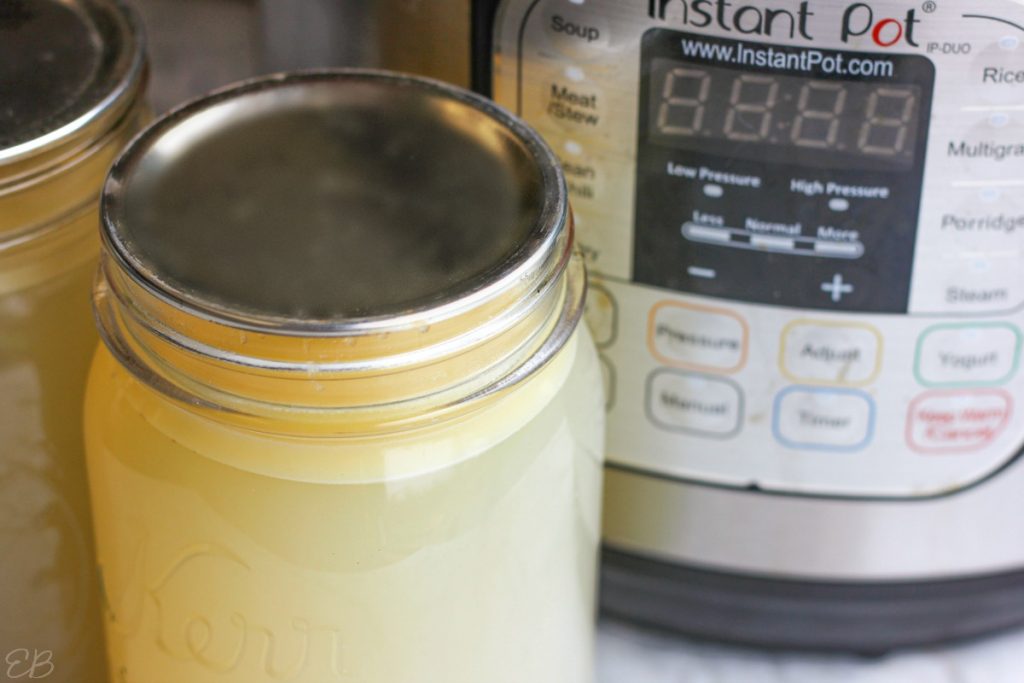
Learn more about the health benefits of bone broth here and here.
Make great soups and learn even more about stocks and broths in my newest cookbook.

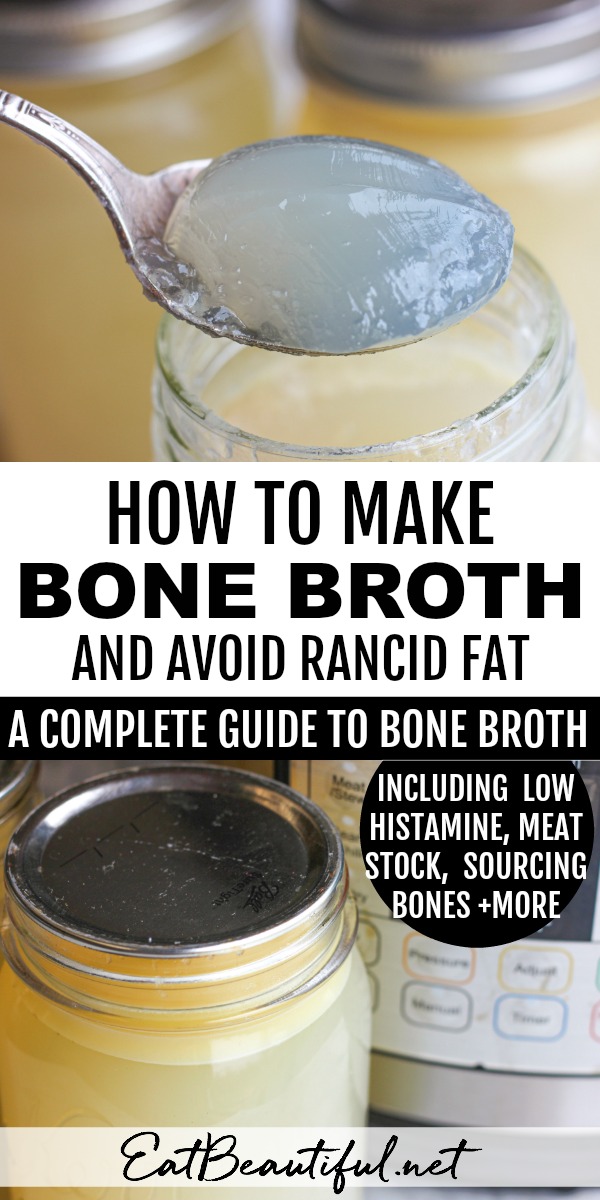
Source: https://eatbeautiful.net/how-make-bone-broth-avoid-rancid-fat/
Belum ada Komentar untuk "What to Do With Beef Bone Fat"
Posting Komentar